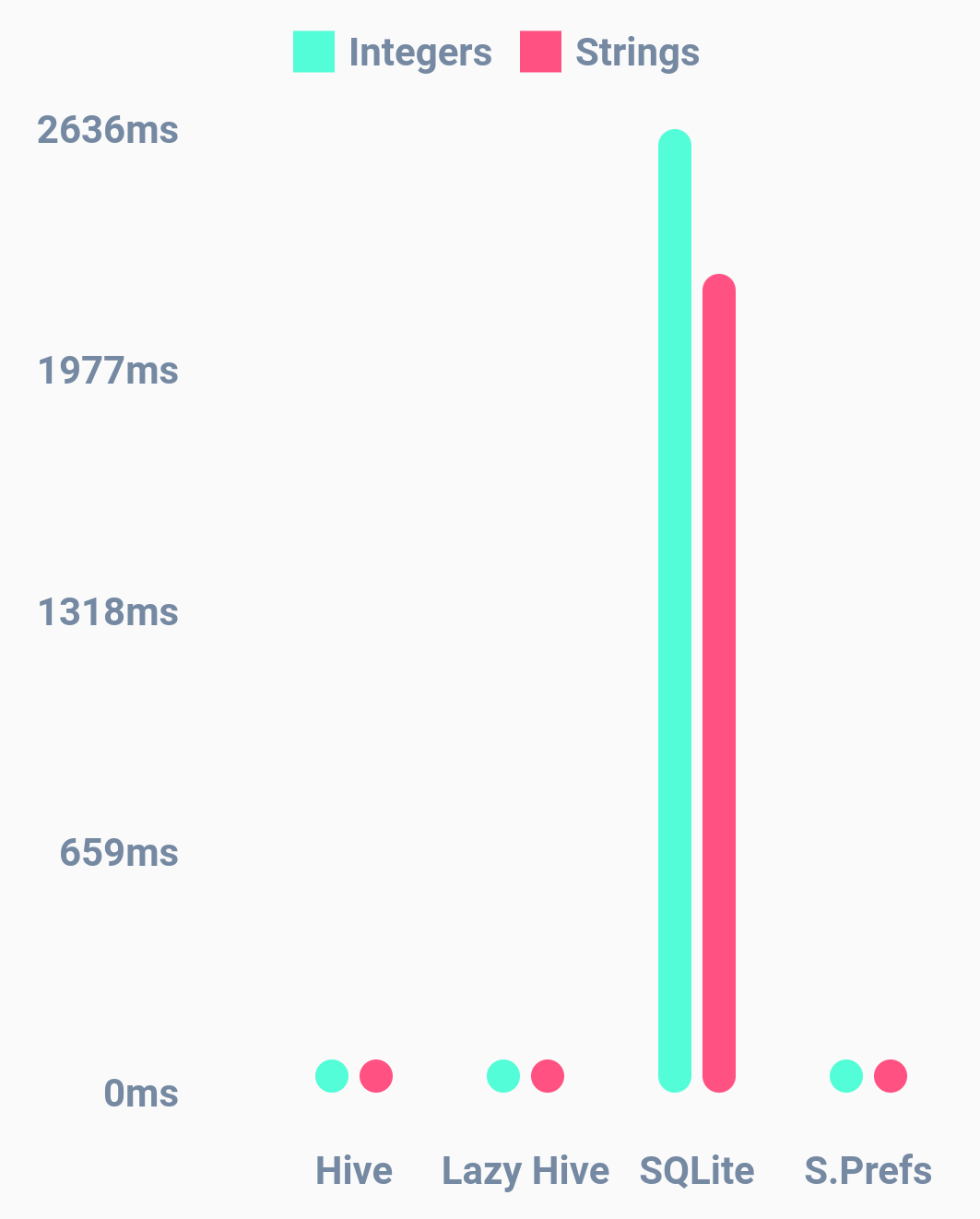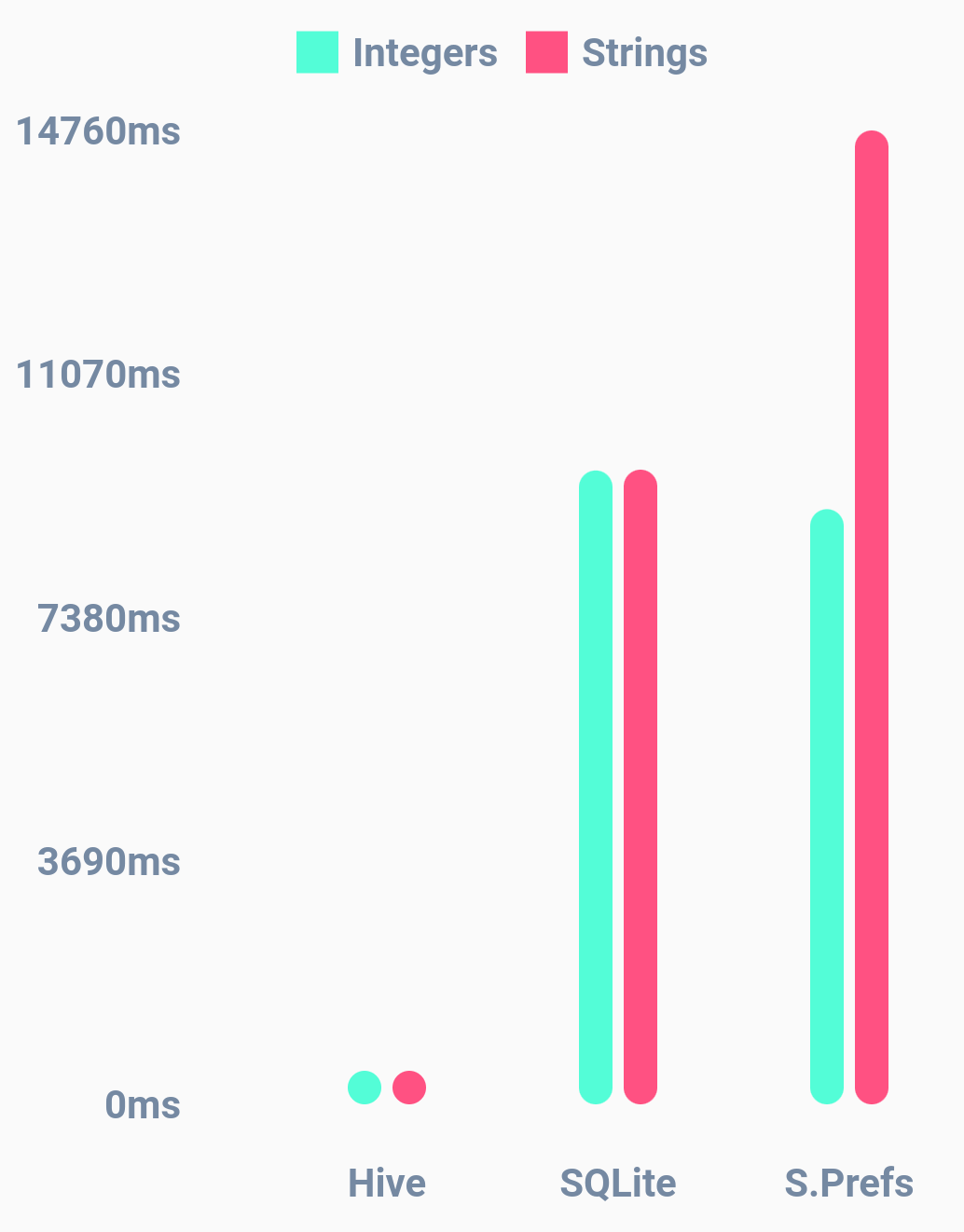Hive is a lightweight and blazing fast key-value database written in pure Dart. Inspired by Bitcask.
For a quick tutorial, see this wonderful post by Tijn van den Eijnde
- 🚀 Cross platform: mobile, desktop, browser
- ⚡ Great performance (see benchmark)
- ❤️ Simple, powerful, & intuitive API
- 🔒 Strong encryption built in
- 🎈 NO native dependencies
- 🔋 Batteries included
Hive CE is a spiritual continuation of Hive v2 with the following new features:
- Flutter web WASM support
- Support for Sets
- A built in Duration adapter
- A
HiveRegistrarextension that lets you register all your generated adapters in one call - Support for constructor parameter defaults
- Freezed support
- Support for generating adapters with classes that use named imports
- Automatic type adapter generation using the
GenerateAdaptersannotation- No more manually adding annotations to every type and field
- Generate adapters for classes outside the current package
You may be considering attempting to make the dev version of Hive v4 work in your project. I strongly advise against this. Not only is Hive v4 not stable, but it is also much slower and less efficient than Hive CE.
This is a comparison of the time to complete a given number of write operations and the resulting database file size:
| Operations | Hive CE | Hive v4 | ||
|---|---|---|---|---|
| 10 | 0.00 s | 0.00 MB | 0.01 s | 1.00 MB |
| 100 | 0.01 s | 0.01 MB | 0.01 s | 1.00 MB |
| 1,000 | 0.05 s | 0.11 MB | 0.07 s | 1.00 MB |
| 10,000 | 0.21 s | 1.10 MB | 0.69 s | 5.00 MB |
| 100,000 | 1.53 s | 10.97 MB | 7.01 s | 30.00 MB |
| 1,000,000 | 19.97 s | 109.67 MB | 89.81 s | 290.00 MB |
Database size in Hive v4 is directly affected by the length of field names in model classes which is not ideal. Also Hive v4 is much slower than Hive CE for large numbers of operations.
The benchmark was performed on an M3 Max MacBook Pro. You can see the benchmark code here.
The hive_ce package is a drop in replacement for Hive v2. Make the following replacements in your project:
pubspec.yaml
# old dependencies
dependencies:
hive: ^2.0.0
hive_flutter: ^1.0.0
dev_dependencies:
hive_generator: ^1.0.0
# new dependencies
dependencies:
hive_ce: latest
hive_ce_flutter: latest
dev_dependencies:
hive_ce_generator: latestDart files
// old imports
import 'package:hive/hive.dart';
import 'package:hive_flutter/hive_flutter.dart';
// new imports
import 'package:hive_ce/hive.dart';
import 'package:hive_ce_flutter/hive_flutter.dart';If you are using a package that depends on Hive v2, you can use the following workaround to force it to use Hive CE:
dependencies:
# Depend on hive_ce to prevent resolving breaking versions
hive_ce: latest
dependency_overrides:
hive:
git:
url: https://github.com/IO-Design-Team/hive_ce
ref: 18f92b53295e9eb77ebd4830d905a72cd404a126
path: overrides/hiveYou can use Hive just like a map. It is not necessary to await Futures.
import 'package:hive_ce/hive.dart';
void example() {
final box = Hive.box('myBox');
box.put('name', 'David');
final name = box.get('name');
print('Name: $name');
}
BoxCollections are a set of boxes which can be similarly used as normal boxes, except of that
they dramatically improve speed on web. They support opening and closing all boxes of a collection
at once and more efficiently store data in indexed DB on web.
Aside, they also expose Transactions which can be used to speed up tremendous numbers of database transactions on web.
On dart:io platforms, there is no performance gain by BoxCollections or Transactions. Only
BoxCollections might be useful for some box hierarchy and development experience.
import 'package:hive_ce/hive.dart';
import 'hive_cipher_impl.dart';
void example() async {
// Create a box collection
final collection = await BoxCollection.open(
// Name of your database
'MyFirstFluffyBox',
// Names of your boxes
{'cats', 'dogs'},
// Path where to store your boxes (Only used in Flutter / Dart IO)
path: './',
// Key to encrypt your boxes (Only used in Flutter / Dart IO)
key: HiveCipherImpl(),
);
// Open your boxes. Optional: Give it a type.
final catsBox = await collection.openBox<Map>('cats');
// Put something in
await catsBox.put('fluffy', {'name': 'Fluffy', 'age': 4});
await catsBox.put('loki', {'name': 'Loki', 'age': 2});
// Get values of type (immutable) Map?
final loki = await catsBox.get('loki');
print('Loki is ${loki?['age']} years old.');
// Returns a List of values
final cats = await catsBox.getAll(['loki', 'fluffy']);
print(cats);
// Returns a List<String> of all keys
final allCatKeys = await catsBox.getAllKeys();
print(allCatKeys);
// Returns a Map<String, Map> with all keys and entries
final catMap = await catsBox.getAllValues();
print(catMap);
// delete one or more entries
await catsBox.delete('loki');
await catsBox.deleteAll(['loki', 'fluffy']);
// ...or clear the whole box at once
await catsBox.clear();
// Speed up write actions with transactions
await collection.transaction(
() async {
await catsBox.put('fluffy', {'name': 'Fluffy', 'age': 4});
await catsBox.put('loki', {'name': 'Loki', 'age': 2});
// ...
},
boxNames: ['cats'], // By default all boxes become blocked.
readOnly: false,
);
}
Hive not only supports primitives, lists, and maps but also any Dart object you like. You need to generate type adapters before you can store custom objects.
import 'package:hive_ce/hive.dart';
class Person extends HiveObject {
Person({required this.name, required this.age});
String name;
int age;
}
Usually this is placed in lib/hive/hive_adapters.dart
import 'package:hive_ce/hive.dart';
import 'person.dart';
part 'hive_adapters.g.dart';
@GenerateAdapters([AdapterSpec<Person>()])
// Annotations must be on some element
// ignore: unused_element
void _() {}
dev_dependencies:
build_runner: latest
hive_ce_generator: latestdart pub run build_runner build --delete-conflicting-outputsThis will generate the following:
- TypeAdapters for the specified AdapterSpecs
- TypeAdapters for all explicitly defined HiveTypes
- A
hive_adapters.g.dartfile containing all adapters generated from theGenerateAdaptersannotation - A
hive_adapters.g.yamlfile - A
hive_registrar.g.dartfile containing an extension method to register all generated adapters
All of the generated files should be checked into version control. These files are explained in more detail below.
The Hive Registrar allows you to register all generated TypeAdapters in one call
import 'dart:io';
import 'package:hive_ce/hive.dart';
import 'package:your_package/hive/hive_registrar.g.dart';
void main() {
Hive
..init(Directory.current.path)
..registerAdapters();
}Extending HiveObject is optional but it provides handy methods like save() and delete().
import 'package:hive_ce/hive.dart';
import 'person.dart';
void example() async {
final box = await Hive.openBox('myBox');
final person = Person(name: 'Dave', age: 22);
await box.add(person);
print(box.getAt(0)); // Dave - 22
person.age = 30;
await person.save();
print(box.getAt(0)); // Dave - 30
}
The Hive schema is a generated yaml file that contains the information necessary to incrementally update the generated TypeAdapters as your model classes evolve.
Some migrations may require manual modifications to the Hive schema file. One example is class/field renaming. Without manual intervention, the generator will see both an added and removed class/field. To resolve this, manually rename the class/field in the schema.
If you already have model classes with HiveType and HiveField annotations, you can take the following steps to migrate to the new GenerateAdapters annotation:
- Convert all default values to constructor parameter defaults
- Add the following to your
build.yamlfile:
targets:
$default:
builders:
hive_ce_generator|hive_schema_migrator:
enabled: true- Run the
build_runner. This will generatelib/hive/hive_adapters.dartandlib/hive/hive_adapters.g.yaml. - Revert the
build.yamlchanges - Remove all explicit
HiveTypeandHiveFieldannotations from your model classes - Run the
build_runneragain
The old method of defining HiveTypes is still supported, but should be unnecessary now that Hive CE supports constructor parameter defaults. If you have a use-case that GenerateAdapters does not support, please create an issue on GitHub.
Unfortunately it is not possible for GenerateAdapters to handle private fields. You can use @protected instead if necessary.
When adding a new non-nullable field to an existing object, you need to specify a default value to ensure compatibility with existing data.
For example, consider an existing database with a Person object:
import 'package:hive_ce/hive.dart';
class Person extends HiveObject {
Person({required this.name, required this.age});
String name;
int age;
}
If you want to add a balance field, you must specify a default value or else reading existing data will result in null errors:
import 'package:hive_ce/hive.dart';
class Person extends HiveObject {
Person({required this.name, required this.age, this.balance = 0});
String name;
int age;
double balance;
}
After modifying the model, remember to run build_runner to regenerate the TypeAdapters
Hive was written with Flutter in mind. It is a perfect fit if you need a lightweight datastore for your app. After adding the required dependencies and initializing Hive, you can use Hive in your project:
import 'package:hive_ce/hive.dart';
import 'package:hive_ce_flutter/hive_flutter.dart';
class SettingsPage extends StatelessWidget {
@override
Widget build(BuildContext context) {
return ValueListenableBuilder(
valueListenable: Hive.box('settings').listenable(),
builder: (context, box, widget) {
return Switch(
value: box.get('darkMode'),
onChanged: (val) {
box.put('darkMode', val);
}
);
},
);
}
}Boxes are cached and therefore fast enough to be used directly in the build() method of Flutter widgets.
The benchmark was performed on a Oneplus 6T with Android Q. You can run the benchmark yourself.
*Take this benchmark with a grain of salt. It is very hard to compare databases objectively since they were made for different purposes.
Copyright 2019 Simon Leier
Licensed under the Apache License, Version 2.0 (the "License");
you may not use this file except in compliance with the License.
You may obtain a copy of the License at
http://www.apache.org/licenses/LICENSE-2.0
Unless required by applicable law or agreed to in writing, software
distributed under the License is distributed on an "AS IS" BASIS,
WITHOUT WARRANTIES OR CONDITIONS OF ANY KIND, either express or implied.
See the License for the specific language governing permissions and
limitations under the License.



